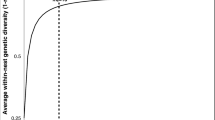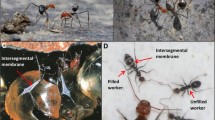Abstract
In social-insect colonies, cooperation among nestmates is generally stabilized by their high genetic similarity. Thus, fitness gained through cooperation drops quickly as the number of reproductive females (queens) increases. In this respect, wasps of the tribe Epiponini have attracted special attention, because the colonies have tens, or even hundreds of queens. It has been empirically or genetically confirmed that relatedness within nestmates can be elevated by a mechanism known as cyclical monogyny, under which new queens are produced only after the number of old queens is reduced to one. Another likely factor that can increase relatedness within nestmates under polygyny is comb partitioning by queens. If queens concentrate their egg laying on one or a subset of the available combs, then workers may be able to rear closer relatives by focusing their work on the comb where they emerged. Using microsatellite markers, we tested the hypotheses of cyclical monogyny and comb partitioning by queens increasing relatedness within nestmates under polygyny in the large-colony epiponine wasp, Polybia paulista. There were no significant differences between relatedness within combs and between combs, and thus we ruled out the possibility that each queen partitions reproduction between combs. However, as cyclical monogyny predicts, a lower effective number of queens contributed to queen production than to worker production. Cyclical monogyny explained well the observed smaller effective number of queens for new queens than that for workers, but failed to explain the stable relatedness values throughout colony cycles.

Similar content being viewed by others
References
Bassam BJ, Caetano-Anolles G, Gresshoff PM (1991) Fast and sensitive silver staining of DNA in polyacrylamide gels. Anal Biochem 196:80–83
Bouwma AM, Bouwma PE, Nordheim EV, Jeanne RL (2003) Adult mortality rates in young colonies of a swarm-founding social wasp (Polybia occidentalis). J Zool 260:11–16
Carpenter JM (1991) Phylogenetic relationships and the origin of social behavior in the Vespidae. In: Ross KG, Matthews RW (eds) The social biology of wasps. Cornell University Press, Ithaca, pp 7–32
Carpenter JM (1993) Biogeographic patterns in the Vespidae (Hymenoptera): two views of Africa and South America. In: Goldplatt P (ed) Biological relationships between Africa and South America. Yale University Press, New Haven, pp 139–155
Fournier D, Aron S, Keller L (2004) Significant reproductive skew in the facultatively polygynous ant Pheidole pallidula. Mol Ecol 13:203–210
Gadagkar R (1992) Disease and social evolution. Curr Sci 63:285–286
Gastreich KR, Strassmann JE, Queller DC (1993) Determinants of high genetic relatedness in the swarm-founding wasp, Protopolybia exigua. Ethol Ecol Evol 5:529–539
Giraud T, Blatrix R, Poteaux C, Solignac M, Jaisson P (2001) High genetic relatedness among nestmate queens in the polygynous ponerine ant Gnamptogenys striatula in Brazil. Behav Ecol Sociobiol 49:128–134
Goodisman M, Ross K (1997) Relationship of queen number and queen relatedness in multiple queen colonies of the fire ant, Solenopsis invicta. Ecol Entomol 22:150–157
Goodnight KF, Queller DC (2001) Relatedness 5.08. Goodnight Software, Houston, Tex
Goudet J (2002) FSTAT, a program to estimate and test gene diversities and fixation indexes 2.9.3.2 http://www.unil.ch/izea/softwares/fstat.html
Hamilton WD (1964a) The genetical evolution of social behaviour. I. J Theor Biol 7:1–16
Hamilton WD (1964b) The genetical evolution of social behaviour. II. J Theor Biol 7:17–52
Hamilton WD (1972) Altruism and related phenomena, mainly in the social insects. Annu Rev Ecol Syst 3:193–232
Hastings MD, Queller DC, Eischen F, Strassmann JE (1998) Kin selection, relatedness, and worker control of reproduction in a large-colony epiponine wasp, Brachygastra mellifica. Behav Ecol 9:573–581
Henshaw MT, Strassmann JE, Queller DC (2000) The independent origin of a queen number bottleneck which promotes cooperation in the African swarm-founding wasp, Polybioides tabidus. Behav Ecol Sociobiol 48:478–483
Herman RA, Queller DC, Strassmann JE (2000) The role of queens in colonies of the swarm-founding wasp Parachartergus colobopterus. Anim Behav 59:841–848
Hughes CR, Queller DC, Strassmann JE, Solís CR, Negrón-Sotomayor JA, Gastreich KR (1993) The maintenance of high genetic relatedness in multiple-queen colonies of social wasps. In: Keller (ed) Queen number and sociality in insects. Oxford University Press, Oxford, pp 153–170
Itô Y, Noll FB, Zucchi R (1997) Initial stage of nest construction in a Neotropical swarm-founding wasp, Polybia paulista (Hymenoptera: Vespidae). Sociobiology 29:227–235
Jeanne RL (1991) The swarm-founding Polistinae. In: Ross KG, Matthews RW (eds) The social biology of wasps. Cornell University Press, Ithaca, pp 191–231
Jeanne RL (2003) Social complexity in the Hymenoptera, with special attention to the wasps. In: Kikuchi T, Azuma N, Higashi S (eds) Genes, behaviors and evolution of social insects. Hokkaido University Press, Sapporo, pp 81–130
Keller L (1995) Social life: the paradox of multiple-queen colonies. Trends Ecol Evol 10:355–360
Keller L (1997) Indiscriminate altruism: unduly nice patterns and siblings. Trends Ecol Evol 12:99–103
Keller L, Reeve HK (1994) Genetic variability, queen number, and polyandry in social Hymenoptera. Evolution 48:694–704
Kojima J (1996) Colony cycle of an Australian swarm-founding paper wasp, Ropalidia romandi (Hymenoptera: Vespidae). Insectes Soc 43:411–420
Kudô K, Zucchi R, Tsuchida K (2003) Initial nest development in the swarm-founding paper wasp, Polybia paulista (Hymenoptera: Vespidae, Epiponini): cases of building of multiple initial combs. J N Y Entomol Soc 111:151–158
Kudô K, Yamane Sô, Mateus S, Tsuchida K, Itô Y, Miyano S, Zucchi R (2004) Parasitism affects worker size in the Neotropical swarm-founding social wasp, Polybia paulista (Hymenoptera, Vespidae). Insectes Soc 51:221–225
Kudô K, Ishiguro N, Tsuchida K, Tsujita S, Yamane Sô, Zucchi R (2005) Polymorphic microsatellite loci for the swarm-founding wasp, Polybia paulista (Hymenoptera: Vespidae). Entomol Sci (in press)
Machado VLL (1985) Analise populacional de colonias de Polybia (Myrapetra) paulista (Ihering, 1896) (Hymenoptera: Vespidae). Rev Bras Zool 2:187–201
Myerscough MR, Oldroyd BP (2004) Simulation models of the role of genetic variability in social insect task allocation. Insectes Soc 51:146–152
Nascimento FS, Tannure-Nascimento IC, Zucchi R (2004) Behavioral mediators of cyclical oligogyny in the Amazonian swarm-founding wasp Asteloeca ujhelyii (Vespidae, Polistinae, Epiponini). Insectes Soc 51:17–23
Noll FB, Zucchi R (2000) Increasing caste differences related to life cycle progression in some neotropical swarm-founding polygynic wasps (Hymenoptera: Vespidae: Epiponini). Ethol Ecol Evol 12:43–65
Nonacs P (1988) Queen number in colonies of social Hymenoptera as a kin-selected adaptation. Evolution 42:566–580
O’Donnell S (1996) RAPD markers suggest genotypic effects on forager specialization in a eusocial wasp. Behav Ecol Sociobiol 38:83–88
Panek LM, Gamboa GJ (2000) Queens of the paper wasp Polistes fuscatus (Hymenoptera: Vespidae) discriminate among larvae on the basis of relatedness. Ethology 106:159–170
Queller DC (1993) Genetic relatedness and its components in polygynous colonies of social insects. In: Keller L (ed) Queen number and sociality in insects. Oxford University Press, Oxford, pp 132–152
Queller DC, Goodnight KF (1989) Estimating relatedness using genetic markers. Evolution 43:258–275
Queller DC, Strassmann JE (1998) Kin selection and social insects. Bioscience 48:165–174
Queller DC, Strassmann JE, Solís CR, Hughes CR, DeLoach DM (1993a) A selfish strategy of social insect workers that promotes social cohesion. Nature 365:639–641
Queller DC, Negrón-Sotomayor J, Strassmann JE, Hughes CR (1993b) Queen number and genetic relatedness in a neotropical wasp, Polybia occidentalis. Behav Ecol 4:7–13
Richards OW (1978) The social wasps of the Americans excluding the Vespidae. British Museum (Natural History), London
Rosengren RL, Sundström L, Fortelius W (1993) Monogyny and polygyny in Formica ants: the result of alternative dispersal tactics. In: Keller L (ed) Queen number and sociality in insects. Oxford University Press, Oxford, pp 308–333
Schmid-Hempel P (1998) Parasites in social insects. Princeton University Press, Princeton, NJ
Shykoff JA, Schmid-Hempel P (1991) Parasites and the advantage of genetic variability within social insect colonies. Proc R Soc Lond B 243:55–58
Simões D, Mechi MR (1983) Estudo sobre a fenologia de Polybia (Myrapetra) paulista Ihering, 1896 (Hymenoptera, Vespidae). Naturalia 8:185–191
Solís CR, Hughes CR, Klingler CJ, Strassmann JE, Queller DC (1998) Lack of kin discrimination during wasp colony fission. Behav Ecol 9:172–176
Strassmann JE (2001) The rarity of multiple mating by females in the social Hymenoptera. Insectes Soc 48:1–13
Strassmann JE, Queller DC, Solís CR, Hughes CR (1991) Relatedness and queen number in the neotropical wasp, Parachartergus colobopterus. Anim Behav 42:461–470
Strassmann JE, Gastreich KR, Queller DC, Hughes CR (1992) Demographic and genetic evidence for cyclical changes in queen number in a neo-tropical wasp, Polybia emaciata. Am Nat 140:363–372
Strassmann JE, Solís CR, Hughes CR, Goodnight KF, Queller DC (1997a) Colony life history and demography of a swarm-founding social wasp. Behav Ecol Sociobiol 40:71–77
Strassmann JE, Barefield K, Solís CR, Hughes CR, Queller DC (1997b) Trinucleotide microsatellite loci for a social wasp, Polistes. Mol Ecol 6:97–100
Strassmann JE, Klingler CJ, Arévalo E, Zacchi F, Husain A, Williams J, Seppä, Queller DC (1997c) Absence of within-colony kin discrimination in behavioural interactions of swarm-founding wasps. Proc R Soc Lond B 264:1565–1570
Strassmann JE, Goodnight KF, Klingler CJ, Queller DC (1998) The genetic structure of swarms and the timing of their production in the queen cycles of neotropical wasps. Mol Ecol 7:709–718
Strassmann JE, Seppä P, Queller DC (2000) Absence of within-colony kin discrimination: foundresses of the social wasp, Polistes carolina, do not prefer their own larvae. Naturwissenschaften 87:266–269
Tsuchida K, Itô Y, Katada S, Kojima J (2000) Genetical and morphological colony structure of the Australian swarm-founding polistine wasp, Ropalidia romandi (Hymenoptera, Vespidae). Insectes Soc 47:113–116
Tsuchida K, Saigo T, Tsujita S, Takeuchi K, Ito N, Sugiyama M (2003) Polymorphic microsatellite loci for the Japanese paper wasp, Polistes chinensis antennalis (Hymenoptera: Vespidae). Mol Ecol Notes 3:384–386
West-Eberhard MJ (1977) The establishment of reproductive dominance in social wasp colonies. Proc VII Cong Int Uni for the Study of Soc Ins Wageningen
West-Eberhard MJ (1978) Temporary queens in Metapolybia wasps: Nonreproductive helpers without altruism? Science 200:441–443
Acknowledgements
We are grateful to E. Kasuya, B. Kranz, M.J. West-Eberhard and two anonymous referees who made invaluable comments and suggestions for the improvement of the text. We also thank K.F. Goodnight for advice on the use of his program Relatedness. This study was supported in part by Research Fellowships of the Japan Society for the Promotion of Science for Young Scientists to K. Kudô (no. 02415) and a Grant-in-Aid for Basic Research from the Japan Ministry of Education, Science and Culture (nos. 10041154 and 12575004) to Sô. Yamane. This study was also supported in part by a Grant-in-Aid for Basic Research from the Japan Ministry of Education, Science and Culture (no. 12304048). This work complies with the laws of Brazil and Japan.
Author information
Authors and Affiliations
Corresponding author
Additional information
Communicated by L. Keller
Rights and permissions
About this article
Cite this article
Kudô, K., Tsujita, S., Tsuchida, K. et al. Stable relatedness structure of the large-colony swarm-founding wasp Polybia paulista. Behav Ecol Sociobiol 58, 27–35 (2005). https://doi.org/10.1007/s00265-004-0903-5
Received:
Revised:
Accepted:
Published:
Issue Date:
DOI: https://doi.org/10.1007/s00265-004-0903-5




